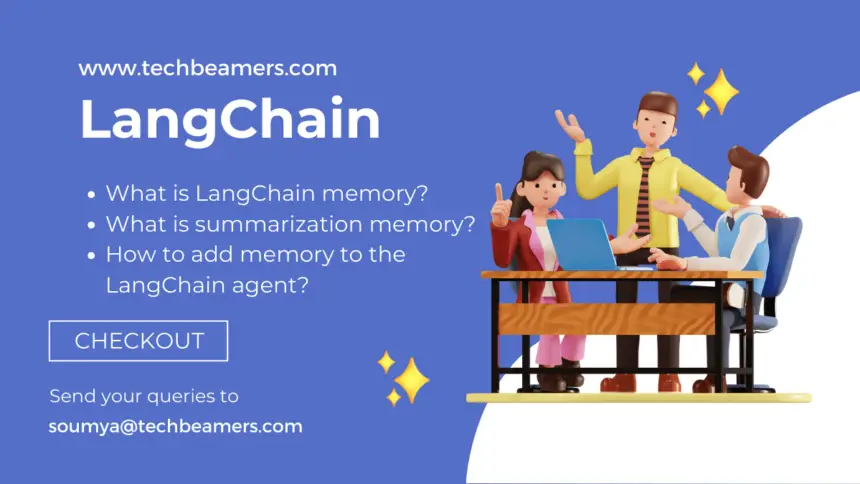Langchain Memory is like a brain for your conversational agents. It remembers past chats, making conversations flow smoothly and feel more personal. Think of it like chatting with a real friend who recalls what you talked about before. This makes the agent seem smarter and more helpful.
Getting Started with Memory in LangChain
Imagine you’re building a super helpful chatbot, like a robot buddy who can talk and remember stuff. Langchain Memory is like extra storage space for the brain. Let’s understand it in more detail.:
Also Read: LangChan Python Tutorial
What is the memory in LangChain?
LangChain helps language models remember things during conversations, making them more natural and engaging.
- It stores conversation history in different types of memory modules.
- The model can access this memory to provide context-aware responses.
- This enables it to understand follow-up questions, recall previous topics, and create a more coherent flow.
- Different memory types are available for specific needs, such as short-term memory, entity extraction, knowledge graphs, and semantic similarity.
- Key benefits include better conversational understanding, adaptability, and potential for personalization.
Different Memory Types
- Buffer Memory: Stores a simple list of recent messages, like a short-term memory.
- Buffer Window Memory: Stores a limited window of conversation history.
- ConversationEntityMemory: Extracts and stores key entities (like people, places, or events) from the conversation.
- ConversationKGMemory: Uses a knowledge graph to store information and relationships between entities.
- VectorStoreRetrieverMemory: Uses vector embeddings to store and retrieve information based on semantic similarity.
Key Benefits
- It helps in making more natural and engaging conversations
- The model can better understand the context and the follow-up questions
- It makes the model learn and adapt over time
- It increases the quality of responses based on user preferences
Check This: Create LangChain ChatBot
What is Summarization Memory?
Imagine you’re having a long, winding chat with a friend. The summarization memory in LangChain is like having someone jot down key points along the way. Here’s the gist:
What it does
- Continuously creates a condensed version of the conversation as it happens. Think of it as a CliffsNotes for your chat.
- This “summary” includes important points, key topics, and the overall flow of the conversation.
- Stores this summary in memory, not the full chat history. This saves space and avoids context overload.
Why it’s useful
- Longer conversations: For extensive chats, remembering everything can be tough. Summarization memory refreshes the model’s understanding without bombarding it with every detail.
- Focused responses: The model can use the summary to generate answers directly relevant to the current topic, avoiding irrelevant tangents.
- Maintaining consistency: It helps the model stay on track, ensuring responses connect to previous discussions and don’t go off on random rabbit holes.
What’s more
- You can inject the summary into prompts, giving the model additional context for even better responses.
- Different models can access and benefit from the same summary, creating a shared understanding across conversations.
Overall, summarization memory makes LangChain models more adaptable and insightful, especially for long and complex conversations. Think of it as a helpful assistant, keeping your chat focused and on point.
How do I Add Memory to My LangChain Agent?
Here’s an algorithm-like breakdown of how to add memory to your LangChain agent:
1. Choose Memory Type
Firstly, we’ll have to identify the type of LangChain memory from the following:
- ConversationBufferMemory: For simple, short-term storage of recent messages.
- BufferWindowMemory: For a limited window of conversation history.
- ConversationEntityMemory: For storing key entities (people, places, events).
- ConversationKGMemory: For building knowledge graphs of entities and relationships.
- VectorStoreRetrieverMemory: For semantic retrieval based on vector embeddings.
2. Import and Create Memory Object
Since our base programming language is Python here. So, below is Python code to set up the memory for the LangChain agent.
from langchain.memory import ConversationBufferMemory as CBM # Replace with your chosen memory class
memory = CBM() # Configure with parameters if needed- This code sets up a simple, short-term memory module for your LangChain agent.
- It’s a common starting point for adding basic memory capabilities.
3. Integrate with LLMChain and Agent
The next step is to add the memory to the LLMChain and the underlying agent.
# Create a language model connector (configured for consistent responses)
llm = OpenAI(temperature=0)
# Let's now build the llm chain
llm_chain = LLMChain(llm=llm, prompt=prompt, memory=memory) # Uses the consistent LLMThe ZeroShotAgent is a function that helps the agent read the input and uses its built-in knowledge to decide on the best way to handle it. It interacts with external tools like search engines, calculators, or translation services to complete the task. The agent returns a single result based on its processing.
4. Utilize Memory in Prompts
With the help of memory, your prompts can become more responsive and natural. The following code tries to give a glimpse of how the prompts can make use of the memory.
# Example prompt with placeholders for memory content
prompt = "Hi {name}, based on your choices, I recommend these options: {suggets_from_memory}. What would you like to do next?"
# Fill placeholders with actual values from memory
new_prompt = prompt.format(
name=memory.get("name"),
suggest_from_memory=memory.get("suggestions")
)
# Send filled prompt to the model for a response
resp = model.run(new_prompt)Key Points:
- Pass the memory object to
LLMChainduring creation. - Include the
LLMChainwith memory in yourAgent. - Use placeholders in prompt messages to leverage stored information.
Conclusion
Let’s leave you with some additional tips:
- Experiment with different memory types to find the best fit for your needs.
- Explore advanced features like entity extraction and knowledge graphs.
- Refer to LangChain documentation for detailed examples and tutorials.
Utilizing memory in prompts is like giving your forms a brain to remember past chats and make smarter decisions. It will help in making more engaging and user-friendly chats.









